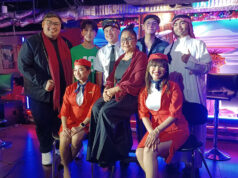WORDS RICARDO M. DE UNGRIA, NESTOR O. JARDIN, AND LISA MACUJA-ELIZALDE | PHOTOGRAPHY JOJO MAMANGUN
Locsin Dance Workshop (LDW), the country’s oldest dance school, celebrated its 70th year with three shows honoring the things its alumni deemed most memorable. The list of 26 icons included people, places, dance productions, a ballet exercise, shoes, food, events, instruments, plants, and even pet dogs.

This taxonomy-defying list prefigured the program for the star-studded shows whose sheer theater Davao will most likely not see again in the next 10 years or so. The first two nights, billed as Icons: Gala, were held at Locsin-Lanang, while the third night, the Icons: Alumni Night, was at Locsin-Quirino. All three shows were woven from three yarns: the ballet of the late matriarch Carmen “Nitang” Dakudao Locsin, the neo-ethnic dance of daughter Agnes, and the Broadway Musical Theater dance of eldest daughter Bing. So the dances ranged from ballet, folk, and neo-ethnic, to flamenco, Broadway, and tango, and into tap, hip-hop, and even an aerobics workout—covering unintentionally the various purposes for dancing.
Each show was one marvelous physical meditation on the supple grace and muscled angularities executable to various rhythms by the human body. Under the amplified music of Bach, Michael Jackson, tribal drums and gongs, Joey Ayala, folk dances, Apo Hiking Society, and Gypsy Kings, among a dozen others, one could hear the soft thuds of bare feet and pointe shoes, the metallic clicks of tap shoes, sharp stabs of flamenco shoes, and the thunderous slams of leather and rubberized hip-hop and Broadway character footwear on the stage. The entire experience was a cubistic adventure into the unexpected. Through every dance, the performers beamed with confidence and exuberance.

“They were all smiling—enjoying what they were doing,” remarked National Artist for Dance Alice Reyes after the third night. The “Magkaugnay” finales tied together the trance-like blaze of dances and kaleidoscope of costumes with suggestions of continuities of traditions, connections, and porousness of forms. In its line dance featuring the interlaced arms from the Bukidnon Dugso and the feet shuffles from the Bagobo, one witnessed strings of generations of dancers disciplined to fine form and lissomeness by teachers Nitang, Bing, and Agnes, with the younger ones already showing verve and readiness to take over.

The LDW Icons and Alumni Night shows proved the rich and deep resources of our country’s dance heritage, as well as the magnificent pool of local talents, some of whom flew in from Germany, Canada, the USA, and Singapore just to perform with some 150 others, the youngest of whom was aged eight and the oldest 73. From the work of Nitang and of her daughters and thence to the “offsprings” of the daughters who either formed their own dance groups or did choreography or taught dance, one could see the legacy of craftsmanship, confidence, and class that Locsin Dance Workshop has always stood for. — RICARDO M. DE UNGRIA
De Ungria, an award-winning poet, is Agnes Locsin’s frequent collaborator.
SHE LIVES DANCE
Agnes Locsin is, in my opinion, one of the best choreographers our country has produced. Having worked with her in Ballet Philippines and in several CCP projects, I’ve admired the painstaking creative process she goes through to produce works that are outstanding for their subject matter, their inspiration and unique style. She has evolved a “neo-ethnic” movement language and form that is inherently Filipino but very contemporary in form.

The process involves research and immersion on the socio-cultural aspects of the subject matter. She immerses herself in the cultural community, studying their way of life, their habits and their movements. From this experience, she formulates a vision for her choreography and slowly puts in place all the aspects of the piece—movements, choreographic patterns and dynamics, music, costumes, sets—into one cohesive and powerful dance.
The results are masterpieces such as Moriones, Paglalakbay, Bagobo, Igorot, Dabaw, Encantada, Baylan, Hinilawod, and La Revolucion Filipina which have all earned a place in the Philippine dance repertoire.
But beyond mastery of her craft, I’ve admired Agnes for her dedication and passion for her work. During her choreographic process, she lives dance, talks dance, thinks dance, and I’m sure even dreams dance in her sleep. — NESTOR O. JARDIN
Jardin was president of the Cultural Center of the Philippines from 2001 to 2009. He is a member of the CCP Board of Trustees.
MAKING HER MARK
I’ve had a chance to work with Agnes as a dancer and I’ve also had the chance to commission her to do ballets for my company and I have to say, there’s just a certain way of moving and dancing her ballets. You know immediately that it is an Agnes Locsin.

She is one of the choreographers who has found her style. She’s made her mark and she really has nothing more to prove as a choreographer, as a creator. I admire her very much and I hope we will be able to work together again. — LISA MACUJA-ELIZALDE
Macuja is a prima ballerina and the artistic director of Ballet Manila.



